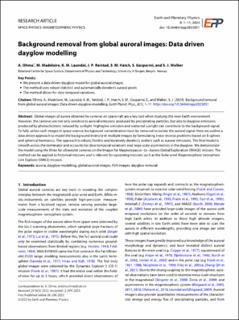| dc.contributor.author | Ohma, Anders | |
| dc.contributor.author | Madelaire, Michael | |
| dc.contributor.author | Laundal, Karl Magnus | |
| dc.contributor.author | Reistad, Jone Peter | |
| dc.contributor.author | Hatch, Spencer Mark | |
| dc.contributor.author | Gasparini, Sara | |
| dc.contributor.author | Walker, Simon | |
| dc.date.accessioned | 2024-02-16T13:58:10Z | |
| dc.date.available | 2024-02-16T13:58:10Z | |
| dc.date.created | 2023-06-30T08:44:14Z | |
| dc.date.issued | 2023 | |
| dc.identifier.issn | 2096-3955 | |
| dc.identifier.uri | https://hdl.handle.net/11250/3118203 | |
| dc.description.abstract | Global images of auroras obtained by cameras on spacecraft are a key tool for studying the near-Earth environment. However, the cameras are sensitive not only to auroral emissions produced by precipitating particles, but also to dayglow emissions produced by photoelectrons induced by sunlight. Nightglow emissions and scattered sunlight can contribute to the background signal. To fully utilize such images in space science, background contamination must be removed to isolate the auroral signal. Here we outline a data-driven approach to modeling the background intensity in multiple images by formulating linear inverse problems based on B-splines and spherical harmonics. The approach is robust, flexible, and iteratively deselects outliers, such as auroral emissions. The final model is smooth across the terminator and accounts for slow temporal variations and large-scale asymmetries in the dayglow. We demonstrate the model by using the three far ultraviolet cameras on the Imager for Magnetopause-to-Aurora Global Exploration (IMAGE) mission. The method can be applied to historical missions and is relevant for upcoming missions, such as the Solar wind Magnetosphere Ionosphere Link Explorer (SMILE) mission. | en_US |
| dc.language.iso | eng | en_US |
| dc.rights | Navngivelse 4.0 Internasjonal | * |
| dc.rights.uri | http://creativecommons.org/licenses/by/4.0/deed.no | * |
| dc.title | Background removal from global auroral images: Data driven dayglow modelling | en_US |
| dc.type | Journal article | en_US |
| dc.type | Peer reviewed | en_US |
| dc.description.version | publishedVersion | en_US |
| cristin.ispublished | true | |
| cristin.fulltext | original | |
| cristin.qualitycode | 1 | |
| dc.identifier.doi | 10.26464/epp2023051 | |
| dc.identifier.cristin | 2159662 | |
| dc.source.journal | Earth and Planetary Physics (EPP) | en_US |
| dc.source.pagenumber | 1-11 | en_US |
| dc.relation.project | Trond Mohn stiftelse: Starting grant | en_US |
| dc.relation.project | Norges forskningsråd: 300844 | en_US |
| dc.relation.project | Norges forskningsråd: 223252 | en_US |
| dc.identifier.citation | Earth and Planetary Physics (EPP). 2023, 7 (6), 1-11. | en_US |
| dc.source.volume | 7 | en_US |
| dc.source.issue | 6 | en_US |

